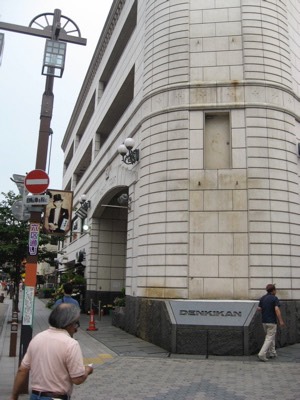My summer class started this week and it has kept me busy. We went to Kabuki on Tuesday and saw versions of Izumi Kyoka's Demon Pond and the Saint of Mt. Koya, both supervised by Bando Tamasaburo (recalling of course Tamasaburo's appearance in Shinoda Masahiro's Yashagaike, though Tamasaburo only appeared in Koya hijiri this time). We had a special screening at the National Film Center on Wednesday, seeing A Page of Madness, Ito Daisuke's An Unforgettable Grudge (1926), and an M. Pathe film from 1908 The Tenth Act of Taikoki. It was interesting seeing some of the same kinds of techniques as A Page of Madness in Ito's film of the same year, helping confirm my sense that Kinugasa's work was less qualitatively than quantitatively different from its contemporaries.
Today we went to Asakusa, which was quite busy with the Hozukiichi. But our aim was less "traditional" Asakusa, than the history of modern entertainment that was near its core. We of course went to Rokku, which used to be the movie theater capital of Japan, but with the Asakusa Toei and the Asakusa Toho gone, there are not many theaters left: just the Chuei Gekijo (foreign rep theater), Meigaza (old yakuza films)--see the intro to these two at Cinema Street--Asakusa Shingekijo (old Japanese films, mostly yakuza), and the Asakusa Seikaikan (old pink films). The Asakusa Toho building still has a sign up front saying "Bright and fun Toho movies!" But there are no such films there, only pachinko, as Toho has mostly abandoned its large urban halls for multiplexes (the Toho Koraku I saw in Kyoto is probably not long for this world). Much of Suwa-san's Hanasareru Gang was shot in Asakusa around 1984 in spots like Hanayashiki and the intersection behind where the Denkikan and the Tokyo Club used to be. The old movie district ironically--and perhaps appropriately--gave the film a Parisian and thus Godardian air.
Asakusa is definitely cleaner and livelier than I recall from the mid-1990s, but especially around Sensoji Temple this has been accomplished by trying to emphasize a "traditional" facade. Yes, there are signs marking Asakusa's core place in Japanese entertainment history in the Rokku district, but facilities like ROX have mostly covered over that history. Japanese authorities have made no effort to preserve Japan's old movie theaters, which is another sign how many try to define Japanese history through "traditional" Japan separated from modern existence (ironically thus often confining that traditional life to museums), and forget its modern history (no wonder many young Japanese don't know about early or mid-20th century history). As far as I know, the only theater designated a bunkazai (cultural property), and this only a local one, is Wakimachi Gekijo in Mima City in Tokushima.
But history still lingers on, sometimes in ironic ways. In Asakusa, old theater names like the Taishokan still live on (that is now a taishu engekijo, on the same spot where the cinema used to be). There is even a office building called the Denkikan, on the spot where the Chiyodakan and the Denkikan used to be. The Denkikan was the first dedicated movie theater in Japan, from 1903, and became a name many theaters across the country adopted. Now you can spot it on this building. I wonder how many passersby know what it means.


